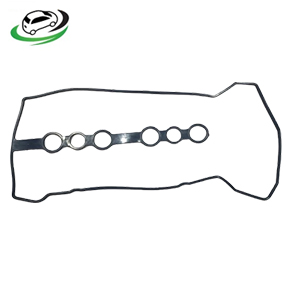Genuine Gasket, Cylinder Head Cover Toyota 1ZZFE 3ZZFE 4ZZFE – 1121322050
The cylinder head cover gasket, commonly known as the valve cover gasket, is a crucial component in an internal combustion engine. Its primary function is to seal the joint between the cylinder head and the valve cover, preventing oil leaks and ensuring the engine operates smoothly. Understanding the design, function, types, common issues, and maintenance of the cylinder head cover gasket is essential for maintaining engine performance and longevity.
Design and Function
The cylinder head cover gasket is a sealing component made from materials like rubber, silicone, or cork. It is designed to fit snugly between the cylinder head and the valve cover, two parts of the engine that house critical components such as camshafts, valves, and timing mechanisms.
Key Functions:
- Sealing Oil: The primary role of the gasket is to prevent engine oil from leaking out of the valve cover. Oil lubricates the moving parts within the cylinder head, and any leakage can lead to inadequate lubrication and potential engine damage.
- Preventing Contaminants: The gasket also keeps contaminants like dirt, dust, and moisture out of the engine. Keeping these elements away from engine components helps maintain engine efficiency and durability.
- Maintaining Pressure: It ensures that the internal pressure within the engine is maintained, which is crucial for optimal performance.
Types of Cylinder Head Cover Gaskets
There are several types of gaskets used for cylinder head covers, each with its advantages:
- Rubber Gaskets: These are the most common and are favored for their flexibility, ease of installation, and good sealing properties. They are suitable for a wide range of temperatures and pressures.
- Silicone Gaskets: Known for their excellent temperature resistance and durability, silicone gaskets are often used in high-performance engines where extreme conditions are encountered.
- Cork Gaskets: Cork gaskets provide good sealing properties and are resistant to oil, but they can deteriorate faster than rubber or silicone. They are less common in modern engines.
- Composite Gaskets: These gaskets combine different materials to enhance sealing properties and durability, often used in specialized applications.
Common Issues
Despite their importance, cylinder head cover gaskets can develop problems over time, primarily due to wear and tear or improper installation. Common issues include:
- Oil Leaks: The most frequent issue with valve cover gaskets is oil leakage. This can happen if the gasket becomes brittle, cracks, or is improperly installed.
- Deterioration: Over time, gaskets can deteriorate due to exposure to high temperatures, pressure, and chemical reactions with engine oil and other fluids.
- Improper Installation: If the gasket is not seated correctly or the bolts are not torqued to the manufacturer’s specifications, it can lead to leaks.
Symptoms of a Faulty Gasket
Identifying a faulty cylinder head cover gasket is essential to prevent further engine damage. Common symptoms include:
- Visible Oil Leaks: Oil spots under the car or oil pooling around the valve cover.
- Burning Oil Smell: An odor of burning oil, often caused by oil leaking onto hot engine parts.
- Engine Misfire: Oil leaking into spark plug wells can cause misfires.
- Decreased Oil Levels: Noticeable drop in engine oil levels without external signs of leakage.
Maintenance and Replacement
Proper maintenance and timely replacement of the cylinder head cover gasket are crucial for engine health. The replacement process involves:
- Safety Precautions: Ensure the engine is cool and disconnect the battery to prevent accidental starts.
- Removing the Valve Cover: Unbolt the valve cover and carefully lift it off.
- Cleaning Surfaces: Remove the old gasket and clean the mating surfaces on the valve cover and cylinder head thoroughly.
- Inspecting for Damage: Check the valve cover for warping or damage that could prevent proper sealing.
- Installing the New Gasket: Place the new gasket onto the valve cover, ensuring it is seated correctly.
- Reassembling: Reattach the valve cover and torque the bolts to the manufacturer’s specifications.
- Testing: Start the engine and check for leaks to ensure the gasket is sealing properly.
Follow us on Facebook for more parts.



